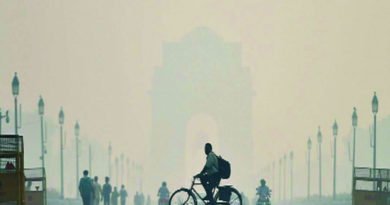A sorry spectacle
The onus is on the people of Delhi to see through the designs of politicos and pressurise them to empower the police to operate without fear or favour
Ostensibly the best equipped, staffed and trained police force in the country, the Delhi Police has had an unimaginably poor run and diminished perception in recent times. If the Police Adequacy Index, derived from national data, part of the Status of Policing in India Report 2019, ranks it as the best-performing force, then its fate in the unseen and under-reported hinterland of the nation is worrisome, to say the least. Even before the gut-wrenching violence in Delhi’s northeast flared up, the police force was in the news for displaying selective bias in managing social unrest in universities across the capital.
However, the cancerous “inner health” of the organisation was in full display a few months ago when police personnel protested against their own senior leaders for their failure to defend the rank and file of the force. The top brass had a tough time pacifying the police personnel, who wore black bands and sloganeered against them. An unprecedented and frightening portent emerged as the law enforcers exposed their own vulnerability to society when they were expected to safeguard the people from societal regression. An embarrassing “acknowledgement” and “acceptance” of the demands of the personnel ensued, though the rot within the system was obvious and was temporarily brushed under the carpet, only to stare in the face soon.
The promise of shanti, sewa and nyaya (peace, service and justice) collapsed and ran hollow as the death toll in the communal riots that broke out in the northeastern parts of the city rose to well over 40. Beyond the stark statistics of the dead and the wounded, it is the failure of the Delhi Police in maintaining a strict law and order situation over a specific area, for about three to four days in the national capital, that is unfathomable. Something, somewhere was terribly amiss as violence of this kind could not have been on account of the fact that the police force was either out-gunned (metaphorically), out-numbered or out-trained by a disorderly mob, however violent. This at a time when security preparedness was at an all-time high in the capital city, given the parallel visit of US President Donald Trump.
It would be incorrect to assume that security imperatives for the presidential visit sucked up or dried the Delhi Police’s resources from the violence-affected northeast area to be concentrated in central Delhi. For the resident resources are both adequate and subject to additional requisitioning if required, especially when violence in the periphery of an all-important event is unacceptable to all. Supreme Court judge KM Joseph succinctly summed up the situation when he said, “If you act the way the law requires you to act, you will see the difference.” Implicitly, the police force had not acted enough, or in time.
However, it is equally important to recognise the constraints under which the Delhi Police functions. It is susceptible to political pressures of all hues, with conflicting interests. It is part of the turf war between the State and the Central Government as the constitutional wiring ensures that it falls under the Home Ministry, through the Lieutenant Governor. It is delinked from the administrative services of the locally-elected Government. This makes the Delhi Police waver between owning and disowning its actions to suit the political narrative of political parties.
Dangers of the larger, looming crisis, of “institutional independence” and its ramifications, are personified by the fate of the force. The top echelons of the police have “proximity” and “vested interests” with the career-impacting politicos, whereas the main body of constabulary suffers from the lack of “voice”, “concern” and “operational independence.” A contrast of the police soldier with that of the armed forces is self-explanatory. The latter is still relatively and structurally more independent, less-interfered with and allowed to operate kinetically. It is not a function of individual superiority as much it is of institutional ethos, circumstances and cocooning — the same family in a village in Haryana sends one son to the Delhi Police and the other to the Indian Army.
The awe-inspiring height of the colourfully-plumed Delhi Police marching contingent with exaggerated hand swings, that would consistently walk away with the trophy for the best marching contingent in the Republic Day parade, is a far cry from the reality and perception on the street. In an embarrassing ode to the prevailing public perception, a political party openly asked Delhiites to make videos of police personnel asking for bribes and harassing people — the accusation resonated and the public empathised with the taint.
On the recent Delhi violence, videos of senior police officials standing pliantly behind politicians making hate speeches complete the picture of political control and subservience. In perhaps a disturbing but hopefully unrelated coincidence, a Delhi High Court judge, who had rightfully slammed the police force for inaction and inefficacy against hate-mongers and alluded to the 1984 riots, was transferred.
For far too long, systemic inefficiencies in the police services have been allowed to fester, perpetuate and worsen. The complete capitulation and meltdown of the Haryana police posse in Panchkula in 2017 could hardly inspire confidence and respect. Requisitioning the Army (as also suggested now) should always be the absolute “last call” as it is bad for the forces, for the Army and for the nation, too. It suggests an unmanageable breakdown.
Beyond all policing reforms and restructuring that are long overdue, if there is one change that can unleash incalculable doses of policing professionalism, it would be to structurally and meaningfully detach its operational functioning from political intrusion and allow it to be “independent” like the judiciary or the armed forces.
Equally, the current situation is a forewarning to these still relatively “independent” institutions of the fate that awaits them if they were to surrender their functional “independence.” The political blame-game among competing political parties in Delhi will only worsen with the stoking of even more polarising, distractive and untamed passions. The onus is on the people of Delhi to see through the designs of these politicos and pressurise them to empower the police to operate without fear or favour. Else, the Delhi Police will continue to carry the can of blame, both conveniently and a bit unfairly.
(The writer, a military veteran, is a former Lt Governor of Andaman & Nicobar Islands)
Bhopinder Singh




